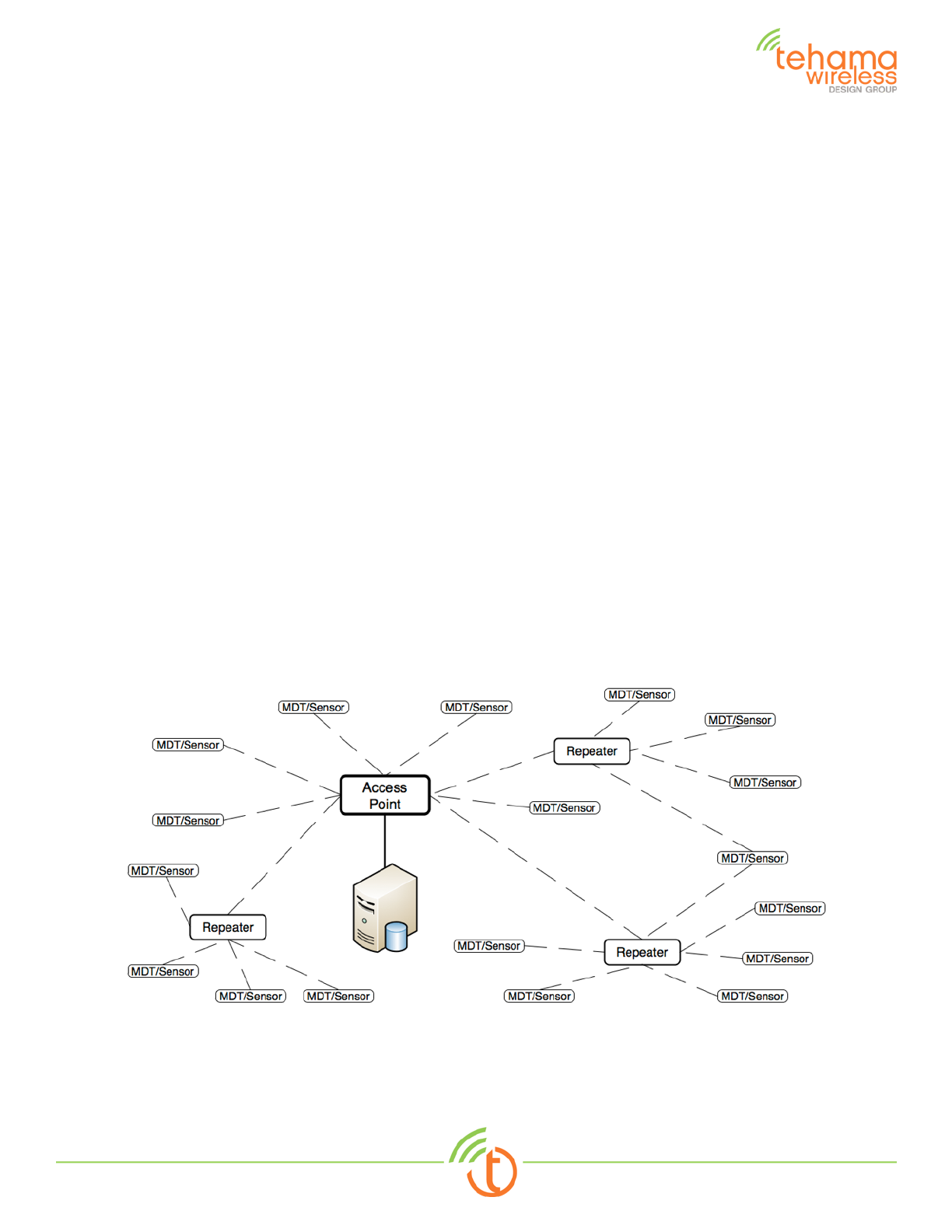Tehama Wireless Design Group TW-101 Repeater / Access Point User Manual WAM User s Guide
Tehama Wireless Design Group Inc. Repeater / Access Point WAM User s Guide
Users Manual

WAM System User Guide
General Description
The Tehama WAM system consists of three device types to remotely monitor various
environmental and utility readings and provide the data to a central database or PC for formal
presentation and reporting. MDT/Sensor devices will be placed in all locations requiring local
monitoring of data. The MDT/Sensors will transmit time stamped data to a Base device, which
receives the data and forwards it to a Database computer through a variety of means (serial
port, USB Port, Ethernet). For MDT/Sensors that are out of range from the Base, Repeater
devices are added in appropriate locations to relay the data between MDT/Sensors and the
Base.
The system operates in the 865MHz (Europe/Asia) and 915Mhz (US) ISM bands using off-the-
shelf FSK RFIC radios. The system operates as a Frequency Hopper over 60 narrow band
frequency channels, incorporating a bidirectional communication link with Acknowledge (ACK)
messages to ensure all data reaches the Base. The MDT/Sensors are battery operated, bursting
data packets at pre-programmed times then shutting down to conserve battery life, estimated
to exceed 4 years. The Base and Repeater units are line powered.
With an average MDT/Sensor transmission rate of four per hour, a single Base can
accommodate many hundreds of MDT/Sensors. Through the use the ACK messages and local
memory in both the MDT/Sensors and Repeaters, the number of MDT/Sensors supported can
exceed a thousand. There is no limit to the number of repeaters, though an average
installation may require one Repeater for every 20-30 MDT/Sensors.
Figure 1: Typical System
WAM User's Guide.pages!1 of 4

A system consists of two or three types of hardware, and two pieces of software:
•Database Software on a PC or Access Point
•Tehama Configuration Utility
•One Base Unit or Access Point
•A variable number of Sensors units, each with 2 AA batteries
•A variable number of Repeater units (optional, depending on size of installation) with
external DC power supply.
Warning
Tehama Installation Tool
You should have received a copy of the Tehama Configuration and Installation Tool software.
This runs on a Windows based PC. More detailed information can be found in the separate
manual for that software.
The tool can be run on the PC either prior to or during a site installation, or when new MDT/
Sensors are added to a system. The tool is used to add configuration data to the database.
Examples of configuration data include the name, type, and location of equipment an MDT/
Sensor is connected to, and alarm trigger settings for the different MDT/Sensors.
MDT/Sensor Configuration
All MDT/Sensors come from the factory with a default factory-set configuration. The following
parameters can be configured in the field by qualified installation staff through a UART style
interface and terminal program running on a PC. There are no parameters which can be
configured on the Base or Receiver. The most common field programmable settings are:
•Monitor Type, defined as the type of device the unit is attached to for measurements.
This includes temperature via thermocouple or thermistor, humidity, CO2, Pressure, or
various pulse type inputs from Utility meters or dry contact outputs from door sensors or
other devices.
•Transmit Interval, defined as the time between scheduled transmissions of temperature
data. A temperature measurement is taken every Transmit Interval, and the data
transmitted within 60 seconds after the measurement. The units for this parameter are
seconds, and the default value is 900 seconds (15 minutes).
•Measure Interval, defined as the time between scheduled temperature measurements.
This is used in conjunction with Temperature Change (see below) and must be smaller than
NOTE: THE MANUFACTURER IS NOT RESPONSIBLE FOR ANY RADIO OR TV
INTERFERENCE CAUSED BY UNAUTHORIZED MODIFICATIONS TO THIS EQUIPMENT.
SUCH MODIFICATIONS COULD VOID THE USER’S AUTHORITY TO OPERATE THE
EQUIPMENT
WAM User's Guide.pages!2 of 4

the Transmit Interval time. A value of 0 for this parameter will disable measurements in
between the Transmit Interval. The units for this parameter are in seconds, with default set
to 0.
•Temperature Change, defined as a percentage change in the Thermistor resistance value
(i.e. temperature) detected by the sensor. A Delta Temp alarm will be generated within the
PC Software if a Sensor reading taken at a Measure Interval is more than Temperature
Change percent from the prior Transmit Interval value. The units for this parameter are
Percent (%), with the default value set to 0.
Usage
THe MDT/Sensors will come with Batteries installed. With the Configuration Tool running on the
PC and the Base or Access Point on and connected to a PC or the Internet, the user will press
and hold the button near the LED window until the LED starts to flash. It will flash slowly at
first, then rapidly flash when a Beacon is seen (from a Repeater or Base/AP), then finally
illuminates for 10 seconds when it successfully communicates with the network.
If configuration changes are required, the case can be opened and the Serial header inserted
into J4 (with the black/green lead toward the center of the board). Once changes are made, a
“reset” command is issued to restart the MDT/Sensor. All changes are stored in non-volatile
memory and will survive a battery change or power off.
Button Usage (for MDT/Sensor and Repeater)
When a unit is off, press and hold for three or four seconds to turn on. LED starts to flash
When unit is on, press and hold for three or four seconds to turn off. LED will be off
A single press can indicate the state of the unit
Constant on LED for 10 seconds means unit successfully communicating to network
Single LED flash indicates the unit is on but not communicating with the network
Double LED flash indicates the unit is OFF
A double press when the unit is on and Connected will trigger an immediate data transmission
Device Placement
With the Base Unit plugged into the PC and the Database software running, the repeater
backbone can be placed. Start with units closer to the Base/AP, and use the LED feedback
indication to verify the range is acceptable. At first just the minimum numbers of repeaters can
be placed, with additional repeaters added to fill in holes after MDT/Sensor placement.
THIS DEVICE COMPLIES WITH PART 15 OF THE FCC RULES. OPERATION IS
SUBJECT TO THE FOLLOWING TWO CONDITIONS:
(1) THIS DEVICE MAY NOT CAUSE HARMFUL INTERFERENCE, AND
(2) THIS DEVICE MUST ACCEPT ANY INTERFERENCE RECEIVED, INCLUDING
INTERFERENCE THAT MAY CAUSE UNDESIRED OPERATION.
WAM User's Guide.pages!3 of 4

Once the initial Repeater placement is complete, the Sensor placement phase begins. Again the
LED feedback can be used to verify that MDT/Sensors are communicating with the network.
Additional repeaters can be placed in areas will minimal coverage. The Configuration Tool can
also be used in the placement phase to provide more detailed information such as Link Quality
and Signal Strength reading generated by MDT/Sensors and Repeaters. In particularly dense
sites such as in modern Hospitals, and Sniffer unit may be used to monitor local radio traffic. A
Sniffer is just a receiving unit that displays any received message on a Laptop over the same
UART interface used to configure MDT/Sensors.
Guidelines
Sensors can be mounted in a number of ways by utilizing velcro strips, tie-wraps, or screws.
Units may be mounted to the wall or other flat surfaces with screws or velcro, and strapped to
pipes or posts by placing tie-wraps through the two slots on the flanged case.
Units should not be placed directly on the metal surface unless no other option is available.
Mounting on a flat metal surface will significantly affect the performance of the device.
Notes
WAM User's Guide.pages!4 of 4